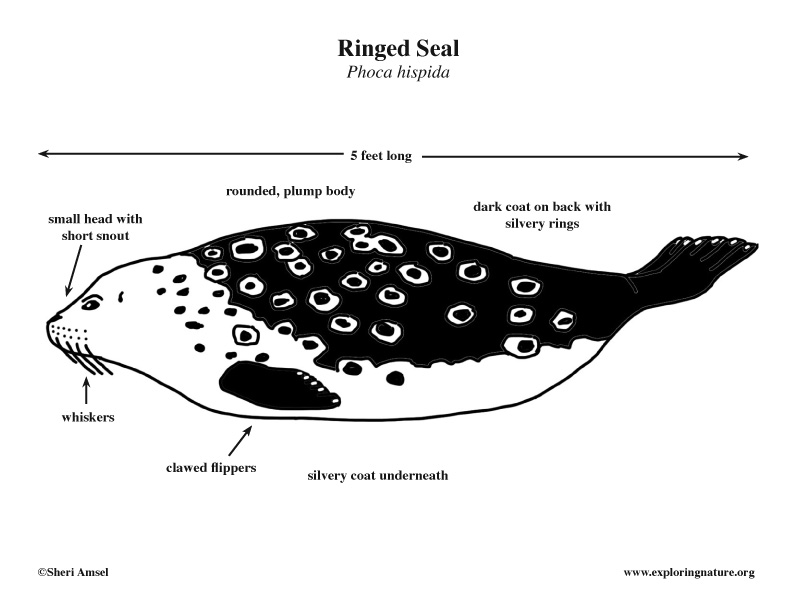

They are found in the coldest oceans of the Northern Hemisphere, close to the North Pole (circumpolar). They are seen on the pack ice off the coasts of Alaska, Northern Canada, Siberia and Finland.
They live on the pack ice when not hunting in the frigid Arctic Ocean.
They are darker on top with lighter, silvery rings. The belly is silver, so when seen from below blends in with the ice above. They are about five feet long and can weigh up to 150 pounds. This makes them the smallest seal in the Arctic.
They tend to live alone, except when breeding or molting. They live out on the pack ice near a break in the ice for a quick escape from land predators. They can use their sharp claws to dig a breathing hole from under the ice. When there is snow fall, they build up the snow into a protective cave near their water hole and protect them from other seals. Ringed seals can stay under water for up to 45 minutes at a time and dive very deep (up to 300 feet).
They eat fish, shrimp, krill, squid, and other invertebrates.
They are hunted by polar bears, killer whales and walruses. Their pups can be killed by wolves, ravens, wolverines, and Arctic foxes. They can be hunted by humans.
Females are pregnant for 9-11 months (gestation). They have one pup in the early spring (March) and nurse them for 1-2 months. Females scrape together the snow on top of the ice into a protective cave in which to have their pup and protect it from predators.
They can live up to 30 years. Their population may become threatened by global climate change with the shrinking pack ice in the Arctic.
Kingdom: Animalia
Phylum: Chordata
Class: Mammalia
Order: Carnivora
Family: Phocidae
Genus: Phoca
Species: hispida
When you research information you must cite the reference. Citing for websites is different from citing from books, magazines and periodicals. The style of citing shown here is from the MLA Style Citations (Modern Language Association).
When citing a WEBSITE the general format is as follows.
Author Last Name, First Name(s). "Title: Subtitle of Part of Web Page, if appropriate." Title: Subtitle: Section of Page if appropriate. Sponsoring/Publishing Agency, If Given. Additional significant descriptive information. Date of Electronic Publication or other Date, such as Last Updated. Day Month Year of access < URL >.
Amsel, Sheri. "Seal (Ringed)" Exploring Nature Educational Resource ©2005-2024. December 13, 2024
< http://www.exploringnature.org/db/view/Seal-Ringed >

